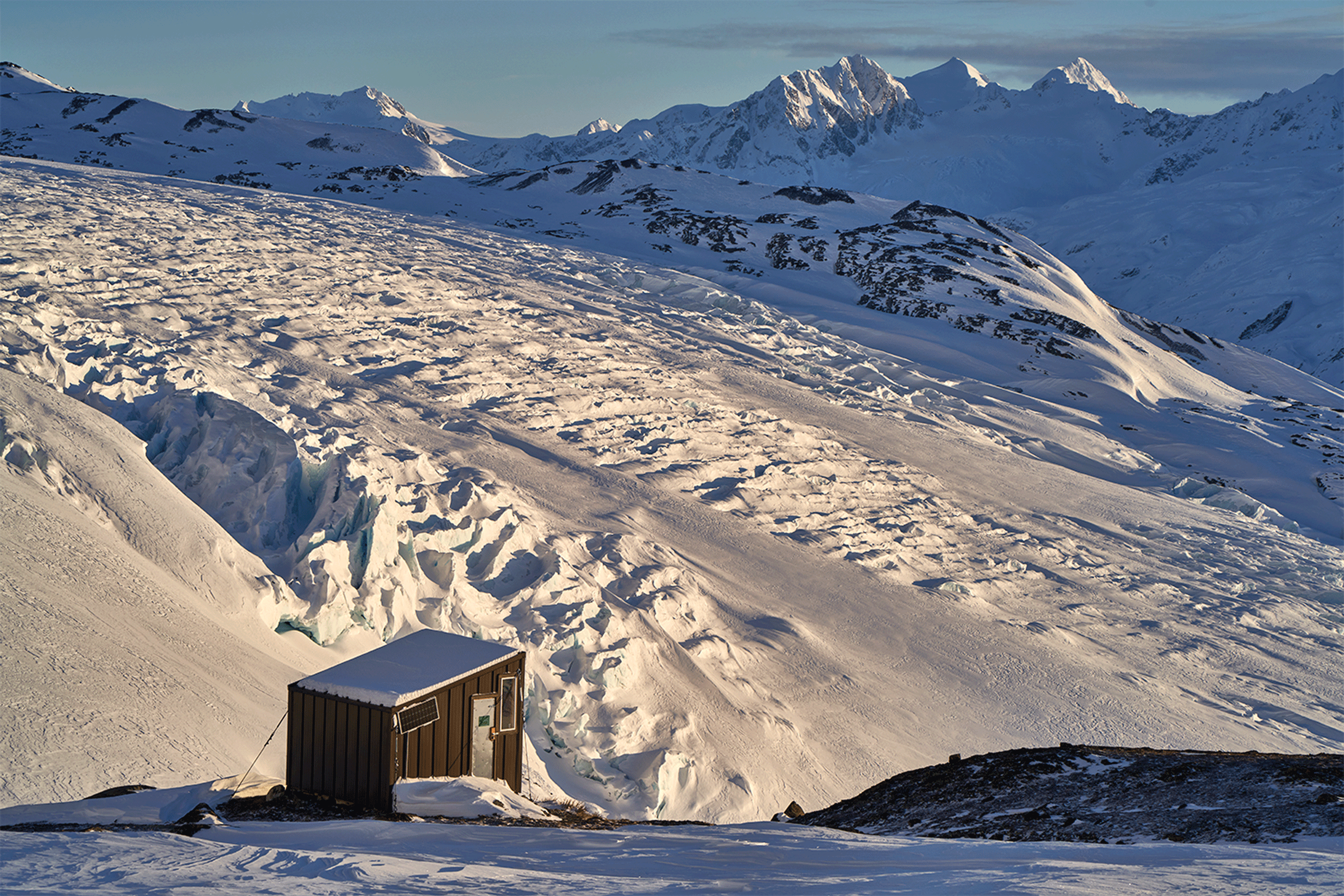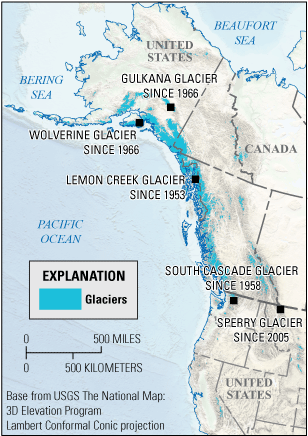U.S. Geological Survey Benchmark Glacier Project
Links
- Document: Report (4.08 MB pdf) , HTML , XML
- Project Site: Glaciers and Climate Project
- Download citation as: RIS | Dublin Core
Introduction
Climate change alters the fate and state of Earth’s glaciers. Mountain glaciers, particularly in Alaska, contribute significantly to sea level rise and its global implications (Zemp and others, 2019). Before reaching the sea, glacier melt provides freshwater for human consumption, agriculture, recreation, and hydropower. Glacier change also affects mountain hazards (Harrison and others, 2018).
Glaciers release melt water during the late summer season, which sustains streamflow between spring snow melt and fall rain (Curran and Biles, 2021). Glaciers are biologically linked to their downstream ecosystems, providing cold water critical for salmon (Wainwright and Weitkamp, 2013) and aquatic habitats (Giersch and others, 2017). Alterations to seasonal stream flow, water chemistry, and temperature (Déry and others, 2009; Bergstrom and others, 2021) caused by glacier loss pose challenges for water resource managers, ecosystems, and downstream communities who depend on these reservoirs of frozen water. For decades, key glaciers situated across western North America have been closely monitored (fig. 1). These consistent field measurements have provided valuable “benchmarks” (Fountain and others, 1997) to understand the physical processes that link glaciers to climate, ecosystems, and hydrology (Matthes, 1939).

Photograph showing the Wolverine Glacier research hut, Alaska. Photograph by Louis Sass, U.S. Geological Survey.
Decades of Data
Five U.S. Geological Survey (USGS) Benchmark Glacier sites span mid to high latitudes and represent climatically distinct regions, from inland to coastal, providing a broad sample of climate response across the continent (fig. 2). Four of the glaciers are considered reference glaciers in the World Glacier Monitoring Service’s internationally coordinated glacier monitoring network (Zemp and others, 2015), with data used regularly in international climate assessment reports (Pfeffer and others, 2014). The long-term record of glacier change captures seasonal and year-to-year variability.

Map showing the USGS Benchmark Glaciers (black squares) that span glacierized regions (blue) of North America (Glacier extent data from the RGI Consortium, 2015).
In 2019, the USGS Benchmark Glacier Project consolidated field practices and data processing methods (O’Neel and others, 2019). This ensures standardized, intercomparable estimates of glacier change across the continent, which boosts scientific value beyond individual glacier monitoring efforts.
Overall, insight gained from decades of USGS glaciology research facilitates glacier change projections, which guide sea level and water resource management strategies.
Modern Measurements
USGS scientists visit the same Benchmark Glacier sites (fig. 2) every spring and fall to make direct measurements of snow accumulation and snow and ice melt. USGS scientists collect snow accumulation data in winter using snow pits and snow cores (fig. 3), while summer melt is measured via annual visits to stakes installed in the glacier surface. Images captured from space allow scientists to document glacier change over entire mountain ranges. Collectively, these data allow scientists to closely track annual changes in both climate and glacier mass. Direct measurements are costly and logistically challenging, but necessary for continuity and validation of newer remote sensing methods of tracking glacier change.

Scientists collect snow accumulation and density data at Gulkana Glacier on April 30, 2020. Photograph by the U.S. Geological Survey.
Conclusion
USGS scientists are expanding the relevance of the Benchmark Glacier network as they layer complementary new technologies atop decades of, and on-going direct glaciological studies. Leveraging high performance computing and satellite imagery, scientists monitor glaciers across diverse climatic zones, providing the holistic understanding of glacier change needed for adaptive water resource strategies.
Understanding glacier change on regional scales using direct field measurements and remotely sensed data allows the USGS Benchmark Project to provide actionable information for downstream science and stakeholders. This includes other scientists focused on species habitat, ecosystem function, glacier geophysics, oceanography, and resource management.
References Cited
Bergstrom, A., Koch, J.C., O’Neel, S., and Baker, E., 2021, Seasonality of solute flux and water source chemistry in a coastal glacierized watershed undergoing rapid change—Wolverine Glacier watershed, Alaska: Water Resources Research, v. 57, article e2020WR028725, 22 p., accessed November 12, 2021, at https://doi.org/10.1029/2020WR028725.
Curran, J. H., and Biles, F. E., 2021, Identification of seasonal streamflow regimes and streamflow drivers for daily and peak flows in Alaska: Water Resources Research, v.57, article e2020WR028425, 21 p., accessed November 12, 2021, at https://doi.org/10.1029/2020WR028425.
Déry, S.J., Stahl, K., Moore, R.D., Whitfield, P.H., Menounos, B., and Burford, J.E., 2009, Detection of runoff timing changes in pluvial, nival, and glacial rivers of western Canada: Water Resources Research, v. 45, no. 4, 11 p., accessed November 12, 2021, at https://doi.org/10.1029/2008WR006975.
Fountain, A.G., Krimmel, R.M., and Trabant, D.C., 1997, A strategy for monitoring glaciers: U.S. Geological Survey Circular 1132, 19 p., accessed November 12, 2021, at https://pubs.er.usgs.gov/publication/cir1132.
Giersch, J.J., Hotaling, S., Kovach, R.P., Jones, L.A., and Muhlfeld, C.C., 2017, Climate-induced glacier and snow loss imperils alpine stream insects: Global Change Biology, v. 23, no. 7, p. 2577–2589, accessed November 12, 2021, at https://doi.org/10.1111/gcb.13565.
Harrison, S., Kargel, J.S., Huggel, C., Reynolds, J., Shugar, D.H., Betts, R.A., Emmer, A., Glasser, N., Haritashya, U.K., Klimeš, J., Reinhardt, L., Schaub, Y., Wiltshire, A., Regmi, D., and Vilímek, V., 2018, Climate change and the global pattern of moraine-dammed glacial lake outburst floods: The Cryosphere, v. 12, no. 4, p. 1195–1209, accessed November 12, 2021, at https://doi.org/10.5194/tc-12-1195-2018.
McNeil, C.J., Florentine, C.E., Bright, V.A.L., Fahey, M.J., McCann, E., Larsen, C.F., Thoms, E.E., Shean, D.E., McKeon, L.A., March, R.S., Keller, W., Whorton, E.N., O'Neel, S., Baker, E.H., Sass, L.C. and Bollen, K.E. 2019, Geodetic data for USGS benchmark glaciers—Orthophotos, digital elevation models, glacier boundaries and surveyed positions (ver 2.0, February 2022): U.S. Geological Survey data release, https://doi.org/10.5066/P9R8BP3K.
O’Neel, S., McNeil, C., Sass, L., Florentine, C., Baker, E., Peitzsch, E., McGrath, D., Fountain, A.G., and Fagre, D., 2019, Reanalysis of the U.S. Geological Survey Benchmark Glaciers—Long-term insight into climate forcing of glacier mass balance: Journal of Glaciology, v. 65, no. 253, p. 850–866, accessed November 12, 2021, at https://doi.org/10.1017/jog.2019.66.
Pfeffer, W., Arendt, A., Bliss, A., Bolch, T., Cogley, J., Gardner, A., Hagen, J.-O., Hock, R., Kaser, G., Kienholz, C., Miles, E.S., Moholdt, G., Mölg, N., Paul, F., Radić, V., Rastner, P., Raup, B.H., Rich, J., and Sharp, M.J., 2014, The Randolph Glacier Inventory—A globally complete inventory of glaciers: Journal of Glaciology, v. 60, no. 221, p. 537–552, accessed November 12, 2021, at https://doi.org/10.3189/2014JoG13J176.
RGI Consortium, 2015, Randolph Glacier Inventory—A Dataset of Global Glacier Outlines, ver. 5 [Alaska, Western Canada, and USA]: Boulder, Colo., National Snow and Ice Data Center, accessed November 12, 2021, at https://doi.org/10.7265/4m1f-gd79.
Wainwright, T., and Weitkamp, L., 2013, Effects of Climate Change on Oregon Coast Coho Salmon—Habitat and Life-Cycle Interactions: Northwest Science, v. 87, no. 3, p. 219–242, accessed November 12, 2021, at https://doi.org/10.3955/046.087.0305.
Zemp, M., Frey, H., Gärtner-Roer, I., Nussbaumer, S.U., Hoelzle, M., Paul, F., Haeberli, W., Denzinger, F., Ahlstrøm, A.P., Anderson, B., Bajracharya, S., Baroni, C., Braun, L.N., Cáceres, B.E., Casassa, G., Cobos, G., Dávila, L.R., Delgado Granados, H., Demuth, M.N., Espizua, L., Fischer, A., Fujita, K., Gadek, B., Ghazanfar, A., Ove Hagen, J., Holmlund, P., Karimi, N., Li, Z., Pelto, M., Pitte, P., Popovnin, V.V., Portocarrero, C.A., Prinz, R., Sangewar, C.V., Severskiy, I., Sigurđsson, O., Soruco, A., Usubaliev, R., and Vincent, C., 2015, Historically unprecedented global glacier decline in the early 21st century: Journal of Glaciology, v. 61, no. 228, p. 745–762, accessed November 12, 2021, at https://doi.org/10.3189/2015JoG15J017.
Zemp, M., Huss, M., Thibert, E., Eckert, N., McNabb, R., Huber, J., Barandun, M., Machguth, H., Nussbaumer, S.U., Gärtner-Roer, I., Thomson, L., Paul, F., Maussion, F., Kutuzov, S., and Cogley, J.G., 2019, Global glacier mass changes and their contributions to sea-level rise from 1961 to 2016: Nature, v. 568, no. 7752, p. 382–386, accessed November 12, 2021, at https://doi.org/10.1038/s41586-019-1071-0.
Suggested Citation
Florentine, C., and McKeon, L.A., 2022, U.S. Geological Survey Benchmark Glacier Project: U.S. Geological Survey Fact Sheet 2022-3050, 2 p., https://doi.org/10.3133/fs20223050.
ISSN: 2327-6932 (online)
ISSN: 2327-6916 (print)
Study Area
| Publication type | Report |
|---|---|
| Publication Subtype | USGS Numbered Series |
| Title | U.S. Geological Survey Benchmark Glacier Project |
| Series title | Fact Sheet |
| Series number | 2022-3050 |
| DOI | 10.3133/fs20223050 |
| Year Published | 2022 |
| Language | English |
| Publisher | U.S. Geological Survey |
| Publisher location | Reston, VA |
| Contributing office(s) | Northern Rocky Mountain Science Center |
| Description | 2 p. |
| Country | Canada, United States |
| Online Only (Y/N) | N |
| Google Analytic Metrics | Metrics page |


